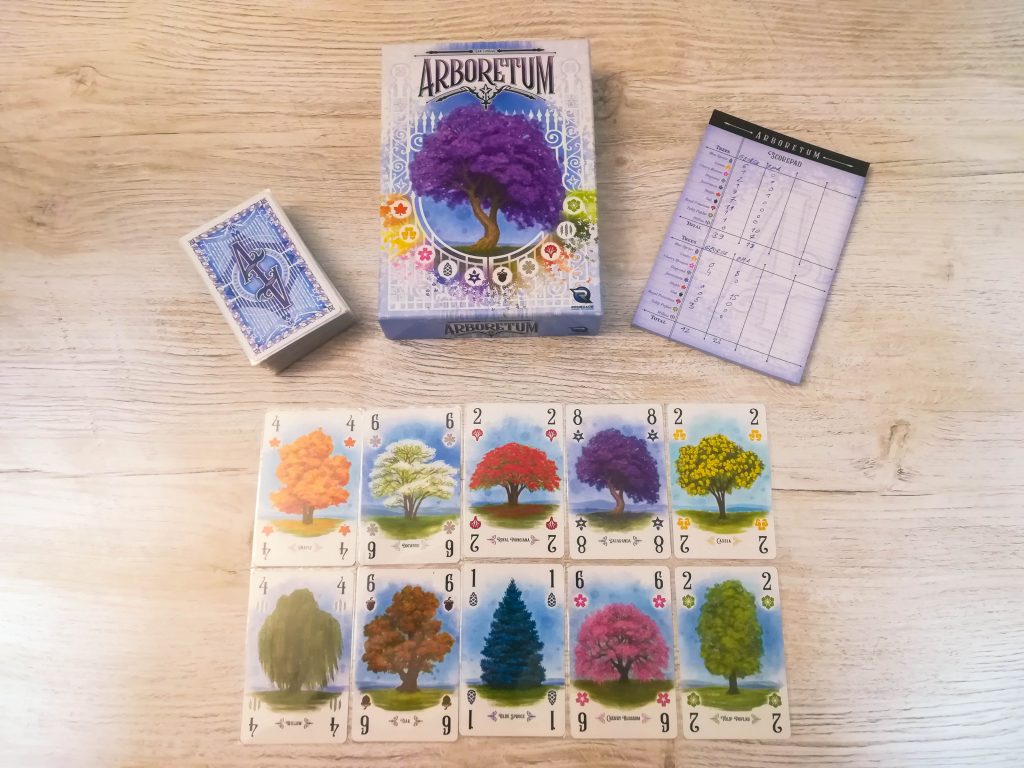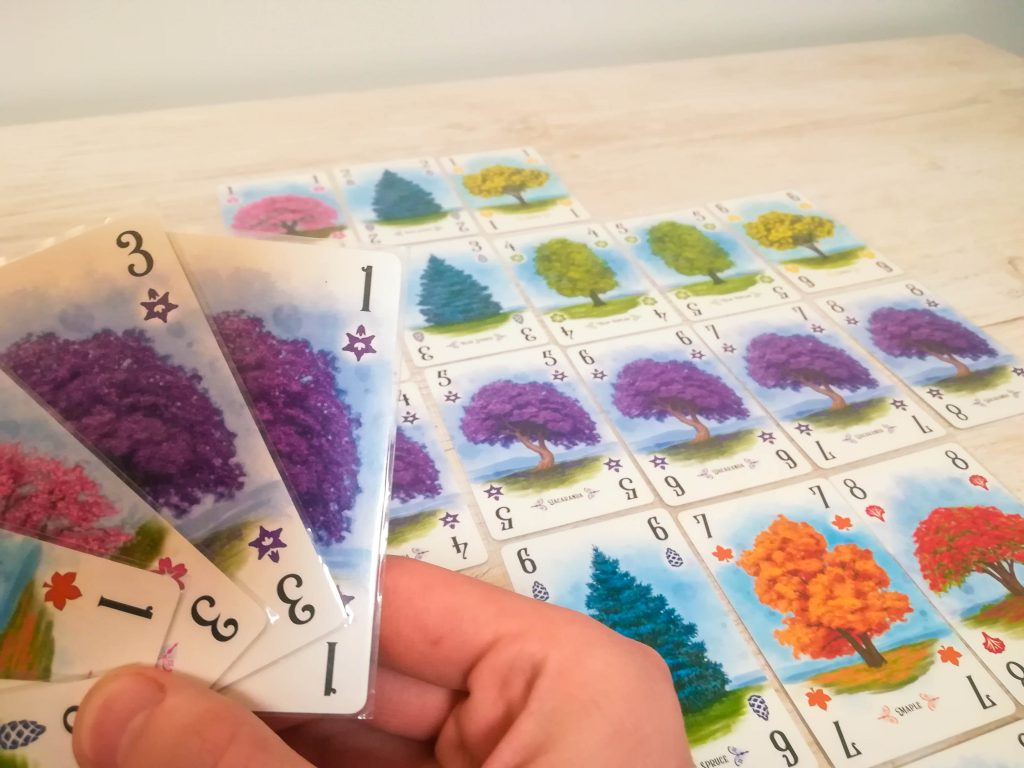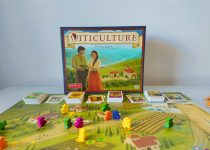Arboretum – Journal Entry #1

In Arboretum, your goal is to plant trees and create beautiful paths for your visitors to explore and admire, only to later discover that someone else stole your idea and made it better (or not)!
At a first glance, the game looks like a colorful tile-laying game where tiles happen to be cards. Although it doesn’t sound like it, this game involves a lot of strategy and may hurt you emotionally (and the others playing with you).
Designed by Dan Cassar, Arboretum is a strategy card game that brings together set collection, tile-laying and hand management mechanics. The box comes with a deck of cards, a rules sheet and a scoring notebook. The deck has 80 cards in ten different colors, each color representing a different species of tree (e.g. Oak, Maple and Willow); each color has cards numbered 1 though 8.

How to play Arboretum
Arboretum is a game for 2 to 4 players. The number of card sets in play is dependent on the number of players. You shuffle these sets together and then deal seven cards to each player. The remaining cards are placed face down in the middle of the table as the draw pile.
On their turn, the active player takes two cards from either the draw pile or the top of any player’s discard pile (including his own). This choice can be done in any combination. After taking these cards, the player then plays one card from hand somewhere in his Arboretum, adjacent to an existing card, and then discards one card to his own discard pile.
The game ends when a player draws the last card from the draw pile. After he finishes his turn, the scoring phase begins.

Scoring
The scoring system adopted by Arboretum is very clever. You score each tree set individually, but only one player can score one set. The rightful scorer of a color is the one who has the highest sum of that color in their hand at the end of the game. However, there’s a trick to that: If a player has the 8 of a color in their hand and another player has the 1 of the same color, the 8 is worth nothing. If there is a tie, all tied players gain the right to score their path of that color.
When scoring a color, you score a path that starts and ends with a card of the same color. The cards along the path can be of any color, but their values must be in increasing order. If you have more than one path for a color, you will only score the one with the highest value.
The winner is the player with the most points. If there is a tie, the player with the most colors in their arboretum wins. If there is still a tie, each tied player must plant a tree. The player whose tree is tallest after five years is declared the winner.

My thoughts about Arboretum
There is a lot more going in this game than you’d think at first. Playing cards and building an arboretum having the scoring system in mind may help you, but it won’t take you far. You see, although you may have the longest path for a tree, it can be worth nothing if you didn’t keep some of that tree in your hand to make sure you’ll be able to score it.
You’ll likely find yourself managing multiple paths in your arboretum, constantly watching your hand and keeping track of what you opponents are building, drawing and discarding. You have to constantly balance what you’re keeping in your hand to win the right to score a path, what you’re discarding, so you won’t discard a card that will allow your opponents to score big, and drawing cards that would stop your opponents from scoring paths.
As the game unfolds, you will realize that there’s more information on the table than you may think. You can see what each player has discarded and played, and you can estimate what’s left in the draw pile. Often, you will find yourself gambling yours odds of scoring a path.
You will constantly fight the limit of holding only 7 cards in your hand. You must consider the importance of each card, and choose to discard the ones with the lowest interest for you. Sometimes, you will be forced to discard a card that would actually be useful to you, only because the others are more valuable. You will have to throw away that card for one turn and retrieve it next time, in hope that no one else decides to take it from you while you wait for your turn to come.

Although the rules state that a 2 player game should be played with 6 sets, we’ve tried playing with all 10 sets one time. It took us 1 hour and 30 minutes to finish the game, but we had a lot of fun, as there were much more trees available to choose from.
I guess I’m an AP (attention paralysis) prone player, because I often find myself spending a lot of time during my turns, taking into consideration all the possible outcomes of my actions. Although I’ve only played this game at 2 players, I can’t imagine the game being very enjoyable at 3 or 4 players, as much of the core balance of the game is about knowing what your opponent is having or might have, which becomes harder as the number of players grows, having multiple hands of unknown cards to consider.
Overall, Arboretum is not a heavy game, although it may seem like one. The rules are easy to grasp, but the scoring system is what makes it a challenging puzzle. It will keep you on your toes until the very end of the game. It is easy to learn, has very few rules, but the decisions you’ll be taking are very meaningful.
Useful info
Designer: Dan Cassar
Publisher: Renegade Game Studios
Players: 2
Time: 30 min
Times played: 5 (at 2 players)
Did you like the review? Follow me on my Instagram page where I post daily photos of games I play and other things. You can also support me on Patreon to gain access to various special content, such as game unboxings, first impressions, polls to decide what games to cover next, and early access to reviews!


